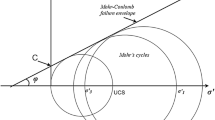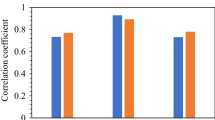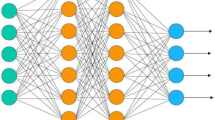Abstract
This paper demonstrates the applicability of cognitive systems or neural networks in predicting the drillibality of rocks and wear factor using engineering properties of rocks. Drillability of rocks is a useful guide for evaluating the suitability of drills for different ground operations. The wear factor of different materials subsequently helps in the selection of proper drills for different drilling operations. Different rocks were tested for Protodyakonov index, impact strength index, shore hardness number, Schmidt hammer number, drillability and micro bit chisels for wear factor. The data obtained from the tests were used to train and test the neural network. Results from the analysis demonstrate that cognitive systems are an effective tool in the prediction and suitability of drilling operations. Application of these predictive models can be a useful tool to obtain the value of these important parameters, they can save time and help to avoid the tedious process of instrumentation.
Similar content being viewed by others
References
C. Aldrich M.A. Reuter J.S.J. Deventer (1994) ArticleTitleThe application of neural nets in the Metallurgical Industry Min. Engg. 7 793–809 Occurrence Handle10.1016/0892-6875(94)90107-4
I. Alexander H. Morton (1990) An Introduction to Neural Computing Chapman and Hall London
R. Battiti (1992) ArticleTitleFirst and second order methods for learning: Between steepest descent and Newton’s method Neural Comput. 4 141–166
G.B. Clark (1982) ArticleTitlePrinciples of rock drilling part-1 Col. Sch. Mines. 1 IssueID77 118
J.G. Cai J. Zhao J.A. Hudson (1998) ArticleTitleComputerization of rock engineering system using neural networks with an expert system Rock Mech. Rock Engg. 31 IssueID3 135–152 Occurrence Handle10.1007/s006030050015
J.L. Conca R. Cubba (1986) ArticleTitleAbrasion resistance hardness Intl. J. Rock Mech. 23 IssueID2 141–49 Occurrence Handle10.1016/0148-9062(86)90340-2
H. Demuth M. Beale (1994) Neural Network ToolBox User’s Guide The Mathworks Inc. MA
A. Erosy M. D. Walker (1995) ArticleTitlePrediction of drill bit performance using multivariate linear regression analysis I.M.M. 104 A79–24
Fish, B.G. (1961) The basic variables in rotary drilling, Min. Quarry Engg, 29–34.
Giri, A. K., Swamliama, C., Singh, T.N. and Singh, D.P. (1997) Strength Properties and their relations with Abrasiveness of some Indian Rocks, 1st Asian Rock Mech. Symp. Korea, 537–541.
M.T. Hagan M. Menhaj (1994) ArticleTitleTraining feedforward networks with the Marquardt algorithm IEEE Trans. Neural Networks 5 IssueID6 989–993 Occurrence Handle10.1109/72.329697
S. Haykin (2001) Neural Networks – A Comprehensive Foundation EditionNumber2 Person Education Asia Delhi
D.T. Howarth (1986) ArticleTitleReview of Rock Drillability and Borability Assessment Methods Transactions of Institution of Mining and Metallurgy. Sec. A. 95 A191–201
J.A. Hudson L. Jing (2002) ArticleTitleNumerical Methods in Rock Mechanics Intl. J. Rock Mech. Min. Sc. 39 409–427 Occurrence Handle10.1016/S1365-1609(02)00065-5
N. Kartam I. Flood J.H. Garrett SuffixJr. (1997) Atificial Neural Networks for Civil Engineers: Fundamentals and Applications ASCE New York
F. Meulenkamp M.A. Grima (1999) ArticleTitleApplication of Neural Networks for the Prediction of the Unconfined Compressive Strength from Equotip Hardness Intl. J. Rock Mech. 36 29–39 Occurrence Handle10.1016/S0148-9062(98)00173-9
A.G. Paithankar G.B. Mishra (1980) ArticleTitleDrillability of rocks in percussive drilling from energy per volume as determined with microbit Min. Engg. 21 1407–1410
Paone, J. Madson, Dick and Bruce, W. E. (1969) Drillabilty Studies, Laboratory Percussive Drilling R.I. 7300, U.S.B.M.
Protodyakonov, M. M. (1962) Mechanical Properties and drillability of rocks, Proc. of the fifth Symp. on Rock Mech., Univ. of Minnesota.
H. Rabia (1982) ArticleTitleSpecific energy as a criterion for drill performance prediction Intl. J. Rock Mech. Min. Sci. and Geomech. Abstr. 19 IssueID1 39–42 Occurrence Handle10.1016/0148-9062(82)90709-4
Riedmiller, B. (1993) Rprop – Description and Implementation Details. Proc IEEE Int Conf NN (ICNN), San Francisco, 586–591.
D. Rumelhart J. McClelland (1986) Parallel Distribution Processing: Explorations in the Microstructure of Cognition, 1–2 MIT Press Cambridge, M.A
Shepherd, R. (1951) Physical properties and drillability of mine rocks, Water Power, 3, 181–183, 252–258, 309–314, 351–356.
Singh, D.P. (1968) Drillability and physical properties of rocks with particular reference to rotary drag drilling, M. Engg. Sc. Thesis, Univ. of Melbourne.
D.P. Singh (1969) ArticleTitleA review of variables involved in drag-bit drilling Aust. Min. 8 IssueID61 54–58
D.P. Singh (1976) ArticleTitleA study of some aspects of drag-bit drilling Met. And Min Review 5 IssueID15 1–4
Singh, T.N. and Monjezi, M. (2003) Abrasivity of some Indian Rocks – an Experimental Approach, Int. Conf. on Drilling, Iran: 39–46.
V.K. Singh D. Singh T.N. Singh (2001) ArticleTitlePrediction of strength properties of some schistose rocks from petrographic properties using artificial neural networks Intl. J. Rock Mech. Min. Sc. 38 IssueID2 269–284 Occurrence Handle10.1016/S1365-1609(00)00078-2
C.J. Talbot M. Sirat (2001) ArticleTitleApplication of Artifical Neural Networks to Fracture Analysis at the Aspo HRL, Sweden: Fracture Sets Analysis Intl. J. Rock Mech. Min. Sc. 38 IssueID5 621–639 Occurrence Handle10.1016/S1365-1609(01)00030-2
C.E. Tsoutrelies (1969) ArticleTitleDetermination of the compressive strength of rock in situ or in test blocks using Diamond Drill Intl. J. Rock Mech. 6 IssueID5 311–322 Occurrence Handle10.1016/0148-9062(69)90008-4
B. Yegnanarayana (1999) Artificial Neural Networks Prentice-Hall of India Pvt. Ltd. New Delhi 117–135
Author information
Authors and Affiliations
Corresponding author
Rights and permissions
About this article
Cite this article
Singh, T.N., Gupta, A.R. & Sain, R. A Comparative Analysis of Cognitive Systems for the Prediction of Drillability of Rocks and Wear Factor. Geotech Geol Eng 24, 299–312 (2006). https://doi.org/10.1007/s10706-004-7547-0
Received:
Accepted:
Issue Date:
DOI: https://doi.org/10.1007/s10706-004-7547-0




